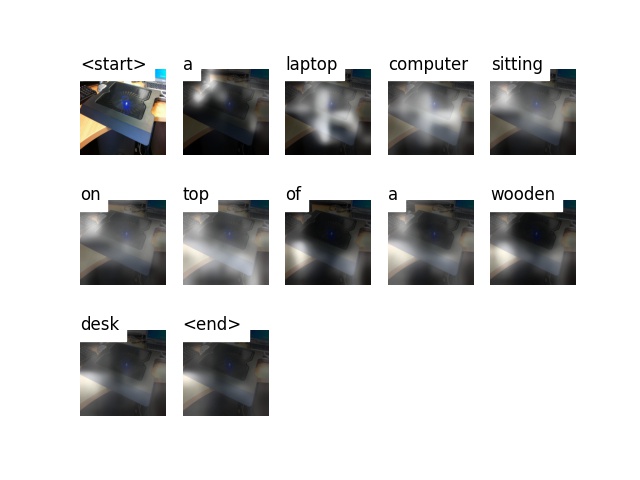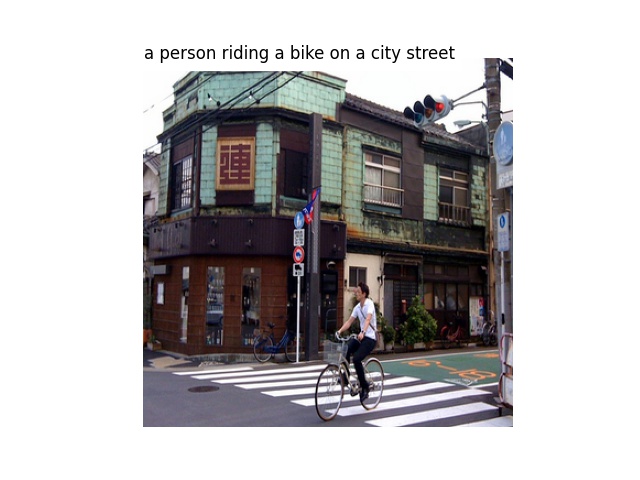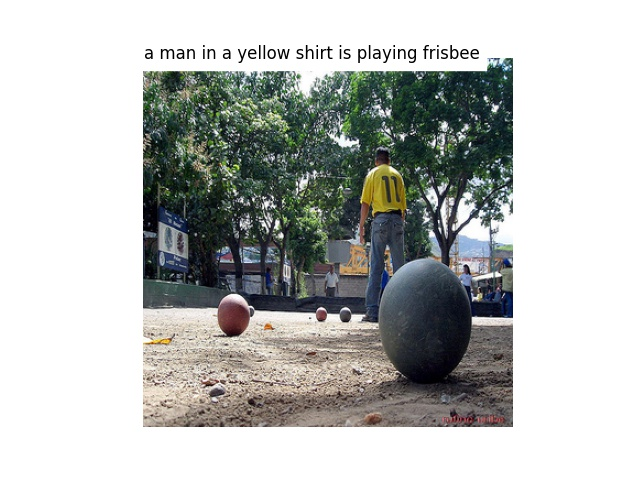-
项目:CV和NLP结合的Attention视频字幕生成算法实现
参考:
课程:学堂在线的清华训练营《驭风计划:培养人工智能青年人才》(满分作业)
paper:《Show, Attend and Tell Neural Image Caption Generation with Visual Attention》
需要的理论知识:LSTM BLEU Resnet-101 COCO数据集 Attention beam算法
理论知识也可以参考博客:
Monte Carlo《Show, Attend and Tell: Neural Image Caption Generation with Visual Attention》论文阅读(详细
《Show and Tell: A Neural Image Caption Generator》论文解读
项目配置、训练过程(环境:百度飞浆平台 V100 cuda9.2):
conda create --prefix=/home/aistudio/external-libraries/caption python=3.6 -y conda init bash conda activate /home/aistudio/external-libraries/caption conda install pytorch=0.4.1 cuda92 -c https://mirrors.tuna.tsinghua.edu.cn/anaconda/cloud/pytorch/linux-64/ -y pip install torchvision==0.2.2 numpy nltk tqdm h5py pillow matplotlib scikit-image scipy==1.1.0 -i https://pypi.tuna.tsinghua.edu.cn/simple python train.py > train_att.log python caption.py --img '/home/aistudio/data/data124850/test2014/COCO_test2014_000000090228.jpg' --model '../code/BEST_checkpoint_coco_5_cap_per_img_5_min_word_freq.pth.tar' --word_map '/home/aistudio/data/data124851/WORDMAP_coco_5_cap_per_img_5_min_word_freq.json'- 1
- 2
- 3
- 4
- 5
- 6
- 7
- 8
- 9
- 10
- 11
- 12
- 13
- 14
实验结果示例:
图中的白色亮光是指注意力,很明显,可以看到对于清晰和明显的图片这个模型还是有较好的效果,注意力也能关注到图片中的重要部分,而且注意力是随着词的变化而改变位置的,例如第2张图,当词是a laptop的时候,注意力正好关注电脑;当词是wooden desk的时候,注意力正好关注着桌子。




核心代码:
import torch from torch import nn import torchvision device = torch.device("cuda" if torch.cuda.is_available() else "cpu") class Encoder(nn.Module): """ Encoder """ def __init__(self, encoded_image_size=14): super(Encoder, self).__init__() self.enc_image_size = encoded_image_size # Pretrained ImageNet ResNet-101 # Remove linear and pool layers resnet = torchvision.models.resnet101(pretrained=True) modules = list(resnet.children())[:-2] self.resnet = nn.Sequential(*modules) # Resize image to fixed size to allow input images of variable size self.adaptive_pool = nn.AdaptiveAvgPool2d((encoded_image_size, encoded_image_size)) self.fine_tune(fine_tune=True) def forward(self, images): """ Forward propagation. :param images: images, a tensor of dimensions (batch_size, 3, image_size, image_size) :return: encoded images """ out = self.resnet(images) # (batch_size, 2048, image_size/32, image_size/32) out = self.adaptive_pool(out) # (batch_size, 2048, encoded_image_size, encoded_image_size) out = out.permute(0, 2, 3, 1) # (batch_size, encoded_image_size, encoded_image_size, 2048) return out def fine_tune(self, fine_tune=True): """ Allow or prevent the computation of gradients for convolutional blocks 2 through 4 of the encoder. :param fine_tune: boolean """ for p in self.resnet.parameters(): p.requires_grad = False # If fine-tuning, only fine-tune convolutional blocks 2 through 4 for c in list(self.resnet.children())[5:]: for p in c.parameters(): p.requires_grad = fine_tune class Attention(nn.Module): """ Attention Network. """ def __init__(self, encoder_dim, decoder_dim, attention_dim): """ :param encoder_dim: feature size of encoded images :param decoder_dim: size of decoder's RNN :param attention_dim: size of the attention network """ super(Attention, self).__init__() self.encoder_att = nn.Linear(encoder_dim, attention_dim) # linear layer to transform encoded image self.decoder_att = nn.Linear(decoder_dim, attention_dim) # linear layer to transform decoder's output self.full_att = nn.Linear(attention_dim, 1) # linear layer to calculate values to be softmax-ed self.relu = nn.ReLU() self.softmax = nn.Softmax(dim=1) # softmax layer to calculate weights def forward(self, encoder_out, decoder_hidden): """ Forward pass. :param encoder_out: encoded images, a tensor of dimension (batch_size, num_pixels, encoder_dim) :param decoder_hidden: previous decoder output, a tensor of dimension (batch_size, decoder_dim) :return: attention weighted encoding, weights """ att1 = self.encoder_att(encoder_out) # (batch_size, num_pixels, attention_dim) att2 = self.decoder_att(decoder_hidden) # (batch_size, attention_dim) att = self.full_att(self.relu(att1 + att2.unsqueeze(1))).squeeze(2) # (batch_size, num_pixels) alpha = self.softmax(att) # (batch_size, num_pixels) z = (encoder_out * alpha.unsqueeze(2)).sum(dim=1) # (batch_size, encoder_dim) return z, alpha class DecoderWithAttention(nn.Module): """ Decoder. """ def __init__(self, cfg, encoder_dim=2048): """ :param attention_dim: size of attention network :param embed_dim: embedding size :param decoder_dim: size of decoder's RNN :param vocab_size: size of vocabulary :param encoder_dim: feature size of encoded images :param dropout: dropout """ super(DecoderWithAttention, self).__init__() self.encoder_dim = encoder_dim self.decoder_dim = cfg['decoder_dim'] self.attention_dim = cfg['attention_dim'] self.embed_dim = cfg['embed_dim'] self.vocab_size = cfg['vocab_size'] self.dropout = cfg['dropout'] self.device = cfg['device'] self.attention = Attention(encoder_dim, self.decoder_dim, self.attention_dim) # attention network self.embedding = nn.Embedding(self.vocab_size, self.embed_dim) # embedding layer self.dropout = nn.Dropout(0.1) self.decode_step = nn.LSTMCell(self.embed_dim + encoder_dim, self.decoder_dim, bias=True) # decoding LSTMCell self.init_h = nn.Linear(encoder_dim, self.decoder_dim) # linear layer to find initial hidden state of LSTMCell self.init_c = nn.Linear(encoder_dim, self.decoder_dim) # linear layer to find initial cell state of LSTMCell self.f_beta = nn.Linear(self.decoder_dim, encoder_dim) # linear layer to create a sigmoid-activated gate self.sigmoid = nn.Sigmoid() self.fc = nn.Linear(self.decoder_dim, self.vocab_size) # linear layer to find scores over vocabulary self.init_weights() # initialize some layers with the uniform distribution # initialize some layers with the uniform distribution self.embedding.weight.data.uniform_(-0.1, 0.1) self.fc.bias.data.fill_(0) self.fc.weight.data.uniform_(-0.1, 0.1) def load_pretrained_embeddings(self, embeddings): """ Loads embedding layer with pre-trained embeddings. :param embeddings: pre-trained embeddings """ self.embedding.weight = nn.Parameter(embeddings) def fine_tune_embeddings(self, fine_tune=True): """ Allow fine-tuning of embedding layer? (Only makes sense to not-allow if using pre-trained embeddings). :param fine_tune: Allow? """ for p in self.embedding.parameters(): p.requires_grad = fine_tune def init_weights(self): """ Initializes some parameters with values from the uniform distribution, for easier convergence. """ self.embedding.weight.data.uniform_(-0.1, 0.1) self.fc.bias.data.fill_(0) self.fc.weight.data.uniform_(-0.1, 0.1) def forward(self, encoder_out, encoded_captions, caption_lengths): """ Forward propagation. :param encoder_out: encoded images, a tensor of dimension (batch_size, enc_image_size, enc_image_size, encoder_dim) :param encoded_captions: encoded captions, a tensor of dimension (batch_size, max_caption_length) :param caption_lengths: caption lengths, a tensor of dimension (batch_size, 1) :return: scores for vocabulary, sorted encoded captions, decode lengths, weights, sort indices """ batch_size = encoder_out.size(0) encoder_dim = encoder_out.size(-1) vocab_size = self.vocab_size # Flatten image encoder_out = encoder_out.view(batch_size, -1, encoder_dim) # (batch_size, num_pixels, encoder_dim) num_pixels = encoder_out.size(1) # Sort input data by decreasing lengths; caption_lengths, sort_ind = caption_lengths.squeeze(1).sort(dim=0, descending=True) encoder_out = encoder_out[sort_ind] encoded_captions = encoded_captions[sort_ind] # Embedding embeddings = self.embedding(encoded_captions) # (batch_size, max_caption_length, embed_dim) # We won't decode at theposition, since we've finished generating as soon as we generate # So, decoding lengths are actual lengths - 1 decode_lengths = (caption_lengths - 1).tolist() # Create tensors to hold word predicion scores and alphas predictions = torch.zeros(batch_size, max(decode_lengths), vocab_size).to(self.device) alphas = torch.zeros(batch_size, max(decode_lengths), num_pixels).to(self.device) # Initialize LSTM state mean_encoder_out = encoder_out.mean(dim=1) h = self.init_h(mean_encoder_out) # (batch_size, decoder_dim) c = self.init_c(mean_encoder_out) for t in range(max(decode_lengths)): batch_size_t = sum([l > t for l in decode_lengths]) preds, alpha, h, c = self.one_step(t, batch_size_t, embeddings, encoder_out, h, c) predictions[:batch_size_t, t, :] = preds alphas[:batch_size_t, t, :] = alpha return predictions, encoded_captions, decode_lengths, alphas, sort_ind def one_step(self, t, batch_size_t, embeddings, encoder_out, h, c): """ :param t: :param batch_size_t: :param embeddings: :param encoder_out: :param h: :param c: :return: """ attention_weighted_encoding, alpha = self.attention(encoder_out[:batch_size_t], h[:batch_size_t]) gate = self.sigmoid(self.f_beta(h[:batch_size_t])) # gating scalar, (batch_size_t, encoder_dim) attention_weighted_encoding = gate * attention_weighted_encoding h, c = self.decode_step( torch.cat([embeddings[:batch_size_t, t, :], attention_weighted_encoding], dim=1), (h[:batch_size_t], c[:batch_size_t])) # (batch_size_t, decoder_dim) preds = self.fc(self.dropout(h)) # (batch_size_t, vocab_size) return preds, alpha, h, c- 1
- 2
- 3
- 4
- 5
- 6
- 7
- 8
- 9
- 10
- 11
- 12
- 13
- 14
- 15
- 16
- 17
- 18
- 19
- 20
- 21
- 22
- 23
- 24
- 25
- 26
- 27
- 28
- 29
- 30
- 31
- 32
- 33
- 34
- 35
- 36
- 37
- 38
- 39
- 40
- 41
- 42
- 43
- 44
- 45
- 46
- 47
- 48
- 49
- 50
- 51
- 52
- 53
- 54
- 55
- 56
- 57
- 58
- 59
- 60
- 61
- 62
- 63
- 64
- 65
- 66
- 67
- 68
- 69
- 70
- 71
- 72
- 73
- 74
- 75
- 76
- 77
- 78
- 79
- 80
- 81
- 82
- 83
- 84
- 85
- 86
- 87
- 88
- 89
- 90
- 91
- 92
- 93
- 94
- 95
- 96
- 97
- 98
- 99
- 100
- 101
- 102
- 103
- 104
- 105
- 106
- 107
- 108
- 109
- 110
- 111
- 112
- 113
- 114
- 115
- 116
- 117
- 118
- 119
- 120
- 121
- 122
- 123
- 124
- 125
- 126
- 127
- 128
- 129
- 130
- 131
- 132
- 133
- 134
- 135
- 136
- 137
- 138
- 139
- 140
- 141
- 142
- 143
- 144
- 145
- 146
- 147
- 148
- 149
- 150
- 151
- 152
- 153
- 154
- 155
- 156
- 157
- 158
- 159
- 160
- 161
- 162
- 163
- 164
- 165
- 166
- 167
- 168
- 169
- 170
- 171
- 172
- 173
- 174
- 175
- 176
- 177
- 178
- 179
- 180
- 181
- 182
- 183
- 184
- 185
- 186
- 187
- 188
- 189
- 190
- 191
- 192
- 193
- 194
- 195
- 196
- 197
- 198
- 199
- 200
- 201
- 202
- 203
- 204
- 205
- 206
- 207
- 208
- 209
- 210
- 211
- 212
- 213
- 214
- 215
- 216
-
相关阅读:
论文解读(GSAT)《Interpretable and Generalizable Graph Learning via Stochastic Attention Mechanism》
redis快速入门
字符串函数和内存函数详解(2)
【iOS开发】——weak底层原理
LeetCode(力扣)216. 组合总和 IIIPython
大数据-玩转数据-Python几种数据采集
python基于django大学生心理健康系统
【前端学习】—多种方式实现数组拍平(十一)
ConcurrentHashMap 成员、方法分析
Java中常用的四种线程池
- 原文地址:https://blog.csdn.net/KPer_Yang/article/details/126255942
